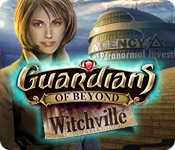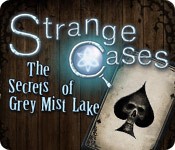Casual Collection - October 2011 releases

Kids aren't the only ones to get treats each October. The month of All Hallows' Eve is always good for witches, ghost stories, and other supernatural gaming thrills. Such was certainly the case this year, as more than a few new casual releases involved deserted ghost towns, eternal curses, twisted carnivals, legendary evils, and tragic tales from the afterlife. From Poe's Premature Burial to a premature death that can only be reversed by fixing the karmic wrongs of past lives, there's plenty of haunted exploring to be done. But all of them share the usual hidden object/lite adventuring formula, and with so many similar themes between them, how do you know where to start? Simple: just keep reading!
Page 1: Dark Tales: Edgar Allan Poe’s The Premature Burial, Reincarnations: Back to Reality
Page 2: Haunted Halls: Fears from Childhood, Guardians of Beyond: Witchville
Page 3: Strange Cases: The Secrets of Grey Mist Lake, Weird Park: Broken Tune
Page 4: Resurrection, New Mexico, Love Story: The Beach Cottage
Page 5: The Dark Hills of Cherai: The Regal Scepter, Campfire Legends: The Last Act
Dark Tales: Edgar Allan Poe’s The Premature Burial
by Merlina McGovern
Being buried alive must surely be one of the most terrifying fates one can experience. Fortunately, in ERS Game Studio’s third Dark Tales outing, Edgar Allan Poe’s The Premature Burial, you won’t personally have to endure the claustrophobia of being locked in a crypt before your time, but instead will enjoy plenty of exploration, puzzling, and a perfectly grim story in this enjoyable, if unremarkable, hidden object adventure.
 As with the earlier games, you play as a partner to the intellectual investigator C. Auguste Dupin. Dupin has been called to a mid-19th century French town to investigate the disappearance of a beautiful young woman named Victorine. The mystery deepens right from the start in a gorgeous cinematic with billowing blue smoke rushing across caramel and orange autumn trees. It materializes into a ghostly woman who beckons to you – she seems to want to help you, and she most definitely is not Victorine. After the encounter, you continue on with Dupin to meet a poor writer named Julien, who was Victorine’s lover. Because of Julien’s lowly station, Victorine married a wealthier man, Renelle, who appears to have a variety of dark secrets.
As with the earlier games, you play as a partner to the intellectual investigator C. Auguste Dupin. Dupin has been called to a mid-19th century French town to investigate the disappearance of a beautiful young woman named Victorine. The mystery deepens right from the start in a gorgeous cinematic with billowing blue smoke rushing across caramel and orange autumn trees. It materializes into a ghostly woman who beckons to you – she seems to want to help you, and she most definitely is not Victorine. After the encounter, you continue on with Dupin to meet a poor writer named Julien, who was Victorine’s lover. Because of Julien’s lowly station, Victorine married a wealthier man, Renelle, who appears to have a variety of dark secrets.
Your travels are set against a lovely, pastoral countryside interspersed with lively animations, like a charming town square with brick-front townhomes topped by red-tiled roofs and slowly rotating weathervanes. Peach sherbet clouds scud across a twilight sky, and a striped awning flutters in the wind. Pigeons coo and waddle around pecking for food near a fountain, and just out of the corner of your eye, a white mist flits from window to window in a building in the background. You’ll explore a ghostly cemetery with crypts overgrown with vines and angel statuary, visit various shops, including a pharmacy and a fish monger’s store, as well as the grounds outside Renelle’s mansion and a variety of rooms within the manor itself. With its multitude of locations, this game would very much have benefitted from a quick travel map to eliminate backtracking.
The character animations and artwork are varied and help evoke a particular feel for each person. Dupin is his typical intellectual self, with his flowing brown locks, full pink lips, and top hat; this isn’t a detective who gets down and dirty. He’s a man who uses “ratiocination” to solve mysteries. Julien, with his long golden hair and worry-etched face, is the very picture of misery. The voice acting can be hit or miss, with the very formal Dupin using proper language to couch his observations to Julien, who sounds more like a laid back surfer than a struggling French artist. As you explore, accordions do a buoyant duet with a piano, while at other times a sad violin simpers in the background.
You won’t find any innovations in this typical hidden object adventure, but the formula is still enjoyable, with a good amount of puzzling fun. The inventory puzzles can often be layered; you’ll need to find several items before you can shoot out a lamp that will illuminate activities you need to conduct in secrecy, for example. For many of these inventory puzzles, you’ll stumble upon workstations that require you to place all of the appropriate materials before assembling them to create a more complicated tool, such as a blow dart or grappling hook. You’ll find some of the items you need during hidden object searches. Some marked items require extra interaction, which can sometimes be difficult to discern in the highly crowded scenes, even with sparkles highlighting one-half of necessary combinations. Unfortunately, even with the wide variety of environments to explore, you’ll still revisit many of these scenes to look for more hidden objects later.
The many logic puzzles you encounter are for the most part your typical tile-rotating, slider, and locking puzzles. Some, however, are interesting variations and deviations from run-of-the-mill types. Finding a combination for a lock may involve some clever fingerprint lifting, and a beautiful constellation puzzle disguises a connect-the-dots exercise. Any puzzles can be skipped, but there’s little help in between, as there are no hints of any kind available beyond hidden object highlights.
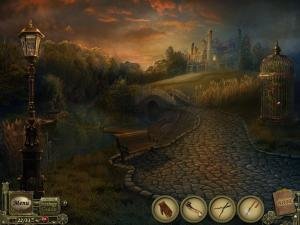 The developers have deviated fairly significantly from Poe’s original tale, which is a morbid meditation on the horrors of being buried alive. Poe evokes a sense of claustrophobia and terror as he tells the various stories of people trapped beneath the devouring earth while life passes by above them. This Dark Tales version takes one of the tales from Poe’s story and fleshes it out, so to speak, over the course of four hours, focusing on the love story between Julien and Victorine. Rather than enclosed and hemmed in, the story here is roaming and unobstructed as you explore the countryside and investigate Victorine’s disappearance.
The developers have deviated fairly significantly from Poe’s original tale, which is a morbid meditation on the horrors of being buried alive. Poe evokes a sense of claustrophobia and terror as he tells the various stories of people trapped beneath the devouring earth while life passes by above them. This Dark Tales version takes one of the tales from Poe’s story and fleshes it out, so to speak, over the course of four hours, focusing on the love story between Julien and Victorine. Rather than enclosed and hemmed in, the story here is roaming and unobstructed as you explore the countryside and investigate Victorine’s disappearance.
The main game resolves nicely, and the bonus chapter in the Collector’s Edition simply tacks on a tale of another woman who may have been a victim before Victorine. While there are some all-new scenes in an underground crypt, the half-hour bonus chapter also sends you back to Renelle’s house, where you’ll explore scenes that you’ve already visited. Both versions of the game offer a nice mix of traditional casual adventuring in this very loose adaptation of Edgar Allan Poe’s The Premature Burial that breaks the story wide open, inviting you to delve into the crypts that should only belong to the dead.
Reincarnations: Back to Reality
by Shuva Raha
Driving on a lonely road one night, a young woman is attacked by four vengeful spirits, who use dangerous tricks like blinding and freezing to crash her car, killing her on the spot. Before reaching its final resting place, Jane's soul arrives in an astral library, where she must investigate her past lives to solve grievances and improve her karma enough to earn another chance at her current life. Those familiar with Vogat Interactive's Reincarnations series will recognise the concept as well as the mystically-gifted protagonist, and there's little new in this third installment, Back to Reality. But the good news is that this edition is lengthier, with four cases to solve over five-plus hours this time, and the quests are a tightly-knit collection of moderately challenging inventory, hidden object and standalone puzzles set against attractive, well-designed scenarios.
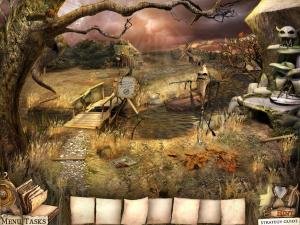 Jane's first incarnation is a village doctor in the early 1900s, who must solve a heinous murder to save the locals who have been blinded by a ghost. The second case is more contemporary, as a museum guard has to recapture a chaotic ancient spirit unwittingly set free by a student. The third story is set at the North Pole, where a child rescued from a shipwreck must free her adoptive family from the clutches of the accidentally released and terribly annoyed Spirit of the North. The final case is the most elaborate and unique, and has a boy trying to save his sister from scientists researching human life longevity via gruesome experiments on a weirdly-forested island in the Pacific. The first and last cases are morbidly fascinating, though the gameplay and styling of the mysterious island is easily the winner.
Jane's first incarnation is a village doctor in the early 1900s, who must solve a heinous murder to save the locals who have been blinded by a ghost. The second case is more contemporary, as a museum guard has to recapture a chaotic ancient spirit unwittingly set free by a student. The third story is set at the North Pole, where a child rescued from a shipwreck must free her adoptive family from the clutches of the accidentally released and terribly annoyed Spirit of the North. The final case is the most elaborate and unique, and has a boy trying to save his sister from scientists researching human life longevity via gruesome experiments on a weirdly-forested island in the Pacific. The first and last cases are morbidly fascinating, though the gameplay and styling of the mysterious island is easily the winner.
Letters, notes and photos reveal more about each case as events progress, and clicking any hotspot provides straightforward instruction about what to do with it. Quests include collecting practical tools as well as pieces of esoteric puzzles, and then using them to resolve the big problems. The 21 hidden object scenes are stocked with somewhat-relevant objects, and often require multiple numbers of items to be collected, which ups the count well beyond the listed dozen. There are some interactive items too, like wheat to be ground into flour, or a wooden idol to be carved on the spot. Each scene yields one useful object and is repeated once, though items found the first time are left out of round two. Many objects are shared between different search screens, and several are hard to find as they are partly hidden under other things. The independent puzzles cover variations of jigsaws, pattern- and image-matching, easy math, light beam redirection, and the often-maddening Lights Out tasks. Some are creative, like fitting animal cutouts on pegs on a wall, and some are fairly challenging, such as a deceptively difficult jigsaw of a seahorse.
There are three modes of difficulty, and without the benefit of sparkles in the tougher two, you have to pixel hunt for hotspots and revisit scenes frequently to check for hidden object areas that may have been reactivated. Playing time is padded with superfluous activities like moving aside leaves one at a time or clicking repeatedly to clear piles of stone or ice, but thankfully multi-purpose tools like hammers and axes stay in the inventory for as long as needed, thus eliminating repetitive quests to gather generic tools. There is a comprehensive task list, though given the linear format of the game, it's more a helpful guide than a crucial reference.
The hundred-odd realistic screens are detailed with shadows, foliage and textures, and distinctly represent each setting, whether the idyllic but creepy village, the museum and its cleverly-engineered tableaux, the Arctic and its Aurora Borealis backdrop, or the outlandish island with its mutant flora and mechanical fauna. A cave-art hidden object screen adds freshness to the typical stashes, and collected items are showcased in appropriate containers like a wicker basket when in the village. The minigames are especially well-designed, with expertly animated doors, rotating parts and special effects. In fact, in-game animation goes beyond the staples of drifting snow and flickering fires to include consistently believable motion, such as a robotic spider standing up or a shark lunging forward. Jane's spirit possessing and leaving her incarnations is also impressive. Unfortunately, some screens suffer from considerable pixellation beyond their native 1024x768 resolution, especially the partially-animated cutscenes, though they do scale to widescreen if you UNcheck the widescreen menu option.

Each scenario has a soundtrack suited to its mood, while sound effects are just right and do not overwhelm the proceedings; together they compensate adequately for the absence of voice acting. Sensible and considerate, Jane is willing and resourceful enough to undo the failings of her past lives. She's blessed with a script that is concise yet precise, albeit sometimes to the point of stating the obvious, and is a companionable partner to play with. Interestingly, though three of her four incarnations are male, her practical personality makes the transitions feel natural and gender-independent.
Back to life after her ordeals in the astral library, the Collector’s Edition bonus chapter sees Jane soon dragged into the depths of a new mystery by yet another disconsolate spirit. Based on the urban legend of the White Lady, this story is about a rich pirate's daughter who was betrayed by her greedy fiancé and has since been exacting her revenge on random young men by drowning them in the aptly-named Disappearance Bay. The hour-long expansion is similar in gameplay to the main segment, with several inventory quests that send Jane back and forth between a series of underwater caves containing dead bodies, treasure, a shark, and four standalone puzzles including a devilish rotator with pearls to be set in three different patterns. The four hidden object screens are repeated once each. A strictly-standalone affair, the extra case is recommended mainly if the original four leave you gasping immediately for more.
Reincarnations: Back To Reality is quite like an episodic television series with a 'case of the week' formula, and loyally follows its two predecessors in concept and gameplay. It's basically a collection of four mini-stories tied together by a flimsy central arc. This is great for variety given the four diverse scenarios, but on the flip side, the stories and characters lack depth as each case is too brief to delve beyond the superficial. But Reincarnations makes up for its simplistic plots with solid execution, and is packed to the brim with engaging casual adventuring. Despite the niggles of the harder modes – tough-to-locate hotspots, hidden object areas reactivated without notice, some clueless wandering – the game provides over five hours of activity-oriented entertainment, and if you're still craving more, serves up a fifth case as the CE extra. And if even that's not enough, rest assured that yet another reincarnation is on the horizon.
Haunted Halls: Fears from Childhood
by Jason L Blair
The story in ERS Game Studio's Haunted Halls: Fears from Childhood isn't an easy one to suss out and gets even stranger as it goes on. The game begins with a cinematic of a little girl getting whisked off into the darkness by an octopus-bodied bogeyman before dropping you into the game proper inside a broken hallway that is seemingly floating in space. The spirit of the kidnapped girl then appears, telling you she and someone named Tim are safe and that you should just go home. Ignoring that advice, you soon pass through what appears to be a shopping mall before finally arriving in a hub world full of six locked doors. Each one leads you to a world wherein you find a child trapped inside a manifestation of his or her worst fear. The main goal of each realm is to free the child from the nightmare and destroy the mirror-like device the bogeyman, known as Blackmore, is using to harness the child's fear energy.
So, yeah. That's the set up.
 Walking through each new door leads to an area vastly different than the one before. Throughout the course of the game, you will explore a graveyard, a history museum, a jungle, a bedroom with windows that lead to different harsh environments, and more. Late in the game, you backtrack to previous areas to gain new items and revisit a few hidden object screens, but for the most part the means to overcome obstacles are contained in the same area in which the puzzles are found.
Walking through each new door leads to an area vastly different than the one before. Throughout the course of the game, you will explore a graveyard, a history museum, a jungle, a bedroom with windows that lead to different harsh environments, and more. Late in the game, you backtrack to previous areas to gain new items and revisit a few hidden object screens, but for the most part the means to overcome obstacles are contained in the same area in which the puzzles are found.
Taken alone, each area tells a shallow but interesting story, from a girl trapped atop a gravestone by an army of grabby bone hands to a boy trapped inside the skeletal remains of a dinosaur. Each area is well-realized and packed with details, with jack-o-lanterns glowing atop an iron fence, a whirling dervish blustering in the barren desert, and an abandoned store full of toys and displays. Finding Tim and the girl, and then whatever device Blackmore is using to capture the fear energy he's stealing, is the main narrative thrust through the game, and unfortunately that broader arc is where the story ultimately falls apart. It seems like there's a decent premise at the heart of the tale, but the presentation is so rushed and the plot points so disjointed that it never gets a chance to come together.
The puzzles at the core of the gameplay are a different matter. The ratio of hidden object screens to inventory puzzles to standalones feels nicely balanced, with no inordinate amount of focus on any one. The inventory puzzles are logical and the standalone puzzles include casual favorites such as sliding puzzles and moving objects across the board in predetermined patterns to their proper slots. I didn't find any of them to be particularly difficult, but they were a nice brief challenge spike amongst the otherwise quick and easy flow of the game.
The hidden object screens are where the game shines. These areas are well-populated with mostly scene-appropriate items strewn about, and two or three objects in each search require interaction or combination to complete. While sometimes this means just lifting a lid to find a feather or digging in the sand to uncover a gem, you'll also be cutting a gourd in half, slicing bread to reveal a pattern inside the loaf, and even activating a rocket to capture its smoke trail. It's fun stuff and goes beyond where a lot of HOGs settle. The two downsides are that sometimes you have to sit through a rather lengthy sequence before the item you need to find finally appears, and some objects are rather finicky when it comes to recognizing the click. For instance, it felt ridiculous that I had to click on the handle of the knife and not the much-larger blade for it to register. This happens fairly frequently throughout the game, but no more than once or twice per screen. You'll revisit most of these HOG screens at least once while dipping back into some three times with a new list of items.
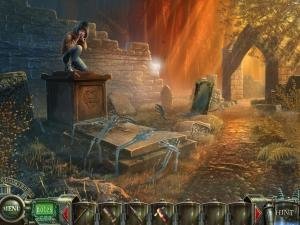 The art and animation is typical of most casual adventure offerings, with flat colored pencil-style illustrations and low-frame count animations that cause moving parts to jump around rather than transition smoothly. The game has very little music that mostly comes in during dramatic moments, instead relying heavily on sound effects to establish its sense of isolation and despair, which they do admirably and in some quantity. Voice acting comes up in major transitional moments as well, such as when you rescue a child or confront the villain, and the actors do the job well enough.
The art and animation is typical of most casual adventure offerings, with flat colored pencil-style illustrations and low-frame count animations that cause moving parts to jump around rather than transition smoothly. The game has very little music that mostly comes in during dramatic moments, instead relying heavily on sound effects to establish its sense of isolation and despair, which they do admirably and in some quantity. Voice acting comes up in major transitional moments as well, such as when you rescue a child or confront the villain, and the actors do the job well enough.
The Collector's Edition includes a bonus chapter that adds an extra half-hour to the main game's three hours of gameplay. Set immediately after the original unsatisfactory ending, the new material has you finally going after the girl you met at the beginning of the game. Some bonus CE segments expand on the initial story while others finish the story that probably should have been finished in the first place. This is definitely one of the latter. This new section takes you back to the space-hallway and the hub world where a new door and environment await. In either version, the disjointedness of the overall story is a definite drawback, but when taken as a collection of casual vignettes, Haunted Halls: Fears from Childhood is an enjoyable game with some inspired hidden object design and great environments. If you are looking for a casual jaunt down some dark hallways, don't be afraid to check this one out.
Guardians of Beyond: Witchville
by Jack Allin
Like clockwork, the witches come out in October, though in Vogat Interactive’s Guardians of Beyond: Witchville, the witches may not be the worst evil you’ll encounter. Playing as a psychic investigator named Alice, you’ll follow your friend Ethan to the ominous-sounding town of Witchville. Though the sign proudly declares itself witch-free since 1690, the townsfolk have recently disappeared, and Ethan along with them. Alice’s paranormal abilities allow her to see them as ghostly figures, but they aren’t dead yet, only cursed to dwell in this netherworld between the living and the dead. And in just six hours, you’ll be doomed to the same fate if you can’t work your way through the game’s many hidden object searches, inventory puzzles, and occasionally difficult logic challenges in time.
 You aren’t really in a rush, of course, as this game plays like a traditional leisurely hidden object adventure. In fact, pretty much the only thing that distinguishes this game from the myriad other haunted town casual games is the presence of two competing spectral guides: a despised fortune teller who foretold the town’s impending destruction, and a wise old scientist who claims his inventions can set everything right. Ethan periodically appears as well, as does a lone other living person in search of his missing parents, though between them they tend to provide more questions than answers. It’s not much to go on, but suffice to say that things are not always what they seem.
You aren’t really in a rush, of course, as this game plays like a traditional leisurely hidden object adventure. In fact, pretty much the only thing that distinguishes this game from the myriad other haunted town casual games is the presence of two competing spectral guides: a despised fortune teller who foretold the town’s impending destruction, and a wise old scientist who claims his inventions can set everything right. Ethan periodically appears as well, as does a lone other living person in search of his missing parents, though between them they tend to provide more questions than answers. It’s not much to go on, but suffice to say that things are not always what they seem.
As usual, however, the wafer-thin plot is really just there as a framework for the gameplay, and there’s a fair bit to do in Witchville. In fact, there’s plenty to do even before you get there, as you’ll first need to prep the ferry just to reach its shores. Once you arrive, you’ll make your way through locations like the gas station, lighthouse, toy store, and carnival. You’ll also dive down to explore a sunken ship and venture out to the standing stones once used (and soon to be used again) for ritual purposes. There’s nothing new here, but it’s a nice mix of scenery that’s all nicely hand-drawn in cool nighttime blues as an angry thunderstorm flashes and rumbles threateningly in the background. The violin-heavy accompaniment provides a suitably atmospheric backdrop, though it starts to get repetitive even with lengthy periods of silence in between pieces – a silence filled with haunting whispers to remind you that there are spirits all around you. That's the only time you'll hear them, however, as the characters don’t speak even in cinematics, which certainly lessens the dramatic impact at times.
Hidden object searches come fairly frequently, but they’re quite well done. There are as many as two interactive objects per screen, and the scenes are displayed fairly close up, making the objects easily recognizable. Better yet, they never appear unannounced in obscure locations and there’s very little repetition. I thought for a long time that I could happily report “no” repetition, but a little does leak in late in the game, even to the point of a few repeat items. Sigh. Items you acquire in these searches and the main environments largely consist of keys and tools with intuitive uses, though occasionally you’ll need to collect multiple items like candles or symbol tiles, and other times missing puzzle components. Sparkles will alert you to interactive items on the easiest level but not the hardest, and you’ll need to do some pixel hunting in the latter, because many objects are invisibly tucked away in close-up insets. A task list and journal should help keep you on track, but you’ll want to use the hint feature sparingly, as it’s prone to laying out exactly what you need to do to accomplish the current objective.
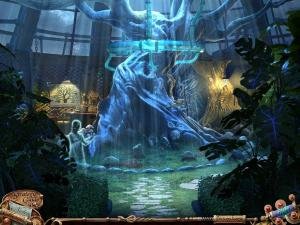 Once you have everything you need, the puzzles can give you a run for your money. Some are simple jigsaws, mini-mazes, and pattern-matching, but several involve aligning imbalanced dials and weights, which can be tricky, and rotating Venn-style rings into a prescribed pattern, which can be trickier. I particularly liked another ring puzzle requiring a rotation around fixed spindles. Once again, the game mostly avoids repetition except for its pipes puzzles, whose connections can be annoyingly difficult just to see, let alone connect. A few other puzzles require codes found elsewhere, but most provide a moderate challenge all on their own without driving you to the skip button.
Once you have everything you need, the puzzles can give you a run for your money. Some are simple jigsaws, mini-mazes, and pattern-matching, but several involve aligning imbalanced dials and weights, which can be tricky, and rotating Venn-style rings into a prescribed pattern, which can be trickier. I particularly liked another ring puzzle requiring a rotation around fixed spindles. Once again, the game mostly avoids repetition except for its pipes puzzles, whose connections can be annoyingly difficult just to see, let alone connect. A few other puzzles require codes found elsewhere, but most provide a moderate challenge all on their own without driving you to the skip button.
All this lite adventuring adds up, providing nearly four full hours of gaming before a rushed but conclusive ending. The Collector’s Edition tacks another 45 minutes onto that as you explore the same town in a kind of dream state that covers everything in a swirling mist. This chapter adds a few extra locations, more hidden object searches, and only a very generic slider and Concentration challenge to pad out the story of three witches wronged by the townsfolk many centuries earlier. It’s a fairly humdrum offering that doesn’t do much to complement the main storyline, merely wrapping up a loose end that seemed awkwardly tacked-on to begin with. Overall, Guardians of Beyond is a pretty pedestrian hidden object adventure, but it’s a diverting enough walk through Witchville, so unless you’re sick to death of the subject matter, don’t let its haunted town premise scare you away.
Strange Cases: The Secrets of Grey Mist Lake
by Jack Allin
Stop me if you’ve heard this before: An FBI agent crashes her car at the outskirts of a literal ghost town, whose spectral inhabitants have been cursed by a witch and trapped in time for 100 years. In order to free their souls and recover her boyfriend, who seems to be the witch’s next intended victim, you’ll need to scour the town for objects both hidden and not, and solve plenty of mostly-easy puzzles along the way. Sound familiar? Like… say… about five minutes ago? Well, yes. Sulus Games’ Strange Cases: The Secrets of Grey Mist Lake scores precisely zero points for originality. As the third game in the series, it also inexplicably abandons some of the gameplay variety offered by its predecessors. It’s still a reasonably solid casual adventure, but it’s haunted by the ghosts of many, many games past.
 Claire Ellery reprises her protagonist role from the first two Strange Cases, but it’s in no way imperative to have played those already. It may even be better not to, as then you won’t miss what you never had. As always, the game’s one unique feature is that in order to trigger a hidden object search, you first need to find a coloured Tarot card displaying the group of items to scavenge. The difference here is, now there is only one colour, one standard list of objects rather than three colours and a blend of lists, silhouettes, and item fragments. The lack of variety is compounded by the need to revisit each scene. There aren’t even any interactive objects to spice up the formula, though you may need to apply inventory to reach the card and trigger the search. The whole “follow the cards” gimmick has also lost its limited narrative appeal, because this time there’s no one actually leaving them behind for you to find.
Claire Ellery reprises her protagonist role from the first two Strange Cases, but it’s in no way imperative to have played those already. It may even be better not to, as then you won’t miss what you never had. As always, the game’s one unique feature is that in order to trigger a hidden object search, you first need to find a coloured Tarot card displaying the group of items to scavenge. The difference here is, now there is only one colour, one standard list of objects rather than three colours and a blend of lists, silhouettes, and item fragments. The lack of variety is compounded by the need to revisit each scene. There aren’t even any interactive objects to spice up the formula, though you may need to apply inventory to reach the card and trigger the search. The whole “follow the cards” gimmick has also lost its limited narrative appeal, because this time there’s no one actually leaving them behind for you to find.
The searches themselves are fine, if a little on the easy side. The same can be said for the rest of the puzzles. From super-easy jigsaws to Simon sequences to pure trial-and-error patterns, some require almost no thought at all. You’ll even play Tic-Tac-Toe three times, always with the first move. The fact that you’re playing a friendly little ghost kid trapped forever in school made me almost want to let him win, but he seemed intent on handing the victory to me. Many puzzles, if not all, will be familiar, as you assemble gears, enter combination codes found elsewhere, and align mismatched buttons and levers. Only a few stand out as noteworthy, including a slider puzzle with cupboard doors that slip over and under each other, and a gem-based slider that you need to solve in three separate stages as you find new components over time. You’ll breeze through most in no time, but a couple near the end may have you eyeing the skip button, like a sliding and rotating block challenge that’s more grief than fun.
You’ll collect inventory as you explore, though most have straightforward uses. It’s still a pain though, because you need to manually click an icon to open the inventory every time. Given that a HUGE section of real estate down the left-hand side of the screen is wasted with only your current objective for much of the game, collected objects easily could have been stored there for easier access. A flashlight is a permanent interface fixture as well, though its use to dissipate purplish-black smoke to reveal collectible runes is always obvious and predictable. Apart from randomly-activated HOG scenes, it’s usually easy to keep on track, which is good since the hint system is rather limited. Either it highlights an objective on the current screen whether you can solve it yet or not, or it points to the nearest exit, which counts as a hint and triggers a lengthy recharge process even on the easier difficulty setting.
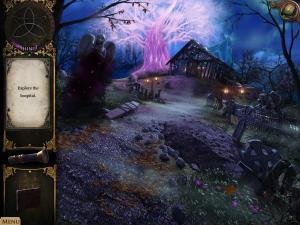 Like the rest of the game, production values are solid but unspectacular. As is the norm for haunted town games, this one takes place exclusively in the cool blues of moonlight, though for an added wrinkle, this moon is in the midst of an eclipse. Small animations like leaves and birds enliven the outdoor scenery, but you’ll spend a fair bit of time inside rather nondescript buildings, exploring the tailor’s and butcher’s home workshops, an undertaker’s clock-filled cabin, the schoolhouse, and a two-floor hospital, which is strangely populated by mechanical robots that are far too advanced for the town’s supposed era. Your many tasks involve finishing the projects left unfinished when the town was cursed, so you’ll fix signs, repair carriages, break into jail, and reunite lost lovers and family. Claire, the witch, and many of the ghosts are voiced, but not all, though given some of the wooden performances delivered, that’s not necessarily a bad thing. The music provides occasional ambience, though it has a slightly sci-fi element that prevents it from ever feeling too tense.
Like the rest of the game, production values are solid but unspectacular. As is the norm for haunted town games, this one takes place exclusively in the cool blues of moonlight, though for an added wrinkle, this moon is in the midst of an eclipse. Small animations like leaves and birds enliven the outdoor scenery, but you’ll spend a fair bit of time inside rather nondescript buildings, exploring the tailor’s and butcher’s home workshops, an undertaker’s clock-filled cabin, the schoolhouse, and a two-floor hospital, which is strangely populated by mechanical robots that are far too advanced for the town’s supposed era. Your many tasks involve finishing the projects left unfinished when the town was cursed, so you’ll fix signs, repair carriages, break into jail, and reunite lost lovers and family. Claire, the witch, and many of the ghosts are voiced, but not all, though given some of the wooden performances delivered, that’s not necessarily a bad thing. The music provides occasional ambience, though it has a slightly sci-fi element that prevents it from ever feeling too tense.
The main adventure wraps up adequately around the three-hour mark before giving way to an entirely unnecessary bonus chapter in the Collector’s Edition. This sends players theoretically back in time to discover the origin of the witch’s curse, though it’s all passed off as a nightmare, making the whole thing feel irrelevant. There’s an extra hour of play offered, including two exceptionally easy sliders, and one puzzle that's so obscure I still haven’t figured out what I was supposed to do. Most of the time is spent collecting items for rituals and potions, many of those from hidden object scenes. Unless you just can’t get enough of more of the same, then, you’re better off waiting for the standard version. Even then, though it’s sufficiently diverting for a few hours, there are so many derivative elements here that deciding whether or not to bother with Strange Cases: The Secrets of Grey Mist Lake is no black and white matter.
Weird Park: Broken Tune
by Jack Allin
I’ve never understood some people’s irrational fear of clowns, but I can begin to imagine it thanks to Diesel Puppet’s Weird Park: Broken Tune. Of course, the clown in this hidden object adventure is a fat, sadistic ghost who plummeted to his death from a highwire juggling act and has since returned to wreak havoc on the now-abandoned circus where he died. He’s not alone either, as a diminutive jester identified as the prankster god Loki is running around loose as well, throwing obstacle after confounding obstacle into your path as you search for a missing reporter. It’s still all rather silly instead of scary, mind you, and though the carnival makes for a twistedly fun backdrop and there are plenty of puzzles to solve, the storyline is threadbare and a reliance on repetitive gameplay, arbitrary objectives, and twiddleware challenges results in nothing more than a fair game overall.
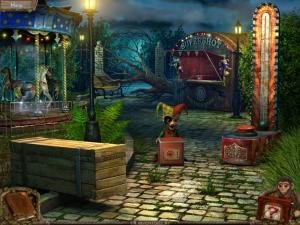 Naturally, it’s nighttime when you reach the Fairy Gate Amusement Park, the moon and lamplights the only think illuminating the carousel, Ferris wheel, puppet theater and other attractions. You’ll also venture indoors to the circus tent, an Egyptian pavilion, and visit a fortune teller’s booth. There’s a kind of perverse pleasure in being creeped out in an environment meant to bring only fun and laughter, though it certainly feels clichéd at this point. Fortunately, the game detours into an even more distorted alternate dimension about halfway through, with warped architecture, upside-down staircases, floating furniture, and melting clocks. There’s little point to the change in scenery beyond adding new areas to continue your chase of the clown, but it adds a welcome extra layer of the macabre.
Naturally, it’s nighttime when you reach the Fairy Gate Amusement Park, the moon and lamplights the only think illuminating the carousel, Ferris wheel, puppet theater and other attractions. You’ll also venture indoors to the circus tent, an Egyptian pavilion, and visit a fortune teller’s booth. There’s a kind of perverse pleasure in being creeped out in an environment meant to bring only fun and laughter, though it certainly feels clichéd at this point. Fortunately, the game detours into an even more distorted alternate dimension about halfway through, with warped architecture, upside-down staircases, floating furniture, and melting clocks. There’s little point to the change in scenery beyond adding new areas to continue your chase of the clown, but it adds a welcome extra layer of the macabre.
Sprinkled throughout these scenes are numerous hidden object searches. Far too many. There’s nothing inherently wrong with them; in fact, at first there’s a nice blend of standard object lists and fragment searches. But soon the developers completely forgot about the latter, and you’re forced to revisit each screen numerous times for different lists of objects. One repeat is bad enough; more than that is just boring filler. There are plenty of inventory puzzles in between, from making popcorn in a vendor’s cart to ringing the strongman’s bell, though most of them involve fairly straightforward tool and item use. Yet the objectives seem very random; you’ll collect some items long before you ever know you need them, while others you can’t collect even when it’s plainly visible in a hidden object search – a fact compounded by the need to return to the same scene for that exact object later. Add the fact that most items require a great deal of backtracking from one end of the park to the next, and the legwork begin to feel tedious, even with the handy hint system that guides you to the nearest currently-solvable task.
The logic puzzles don’t repeat exactly, but they too show a disappointing lack of variety. I have one word to describe the vast majority of them: alignment. Time and time again you’ll flip switches, hit buttons, and rotate rings and tiles and clock hands, each of which moves the other elements around it to keep everything out of whack. It’s hard to call these easy or hard, because solving them has as much to do with lucky experimentation as strategizing. But suffice to say, at least a few are likely to trip you up for quite a while. You can skip any, but with no difficulty options to choose from, it’s all or nothing. A symbol-based Simon sequence is also needlessly punishing, as it goes on interminably and you’re forced to start over from the beginning if you get a single one wrong. A few puzzles like matching themes at the shooting gallery are much easier (and more entertaining) but not nearly as prominent.
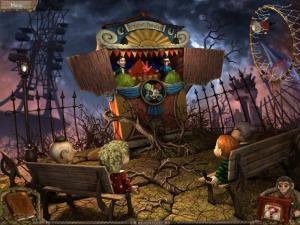 In keeping with the repetition theme, the music provides a nice, understated backdrop of mainly keyboard and chimes, though the few tracks soon start to sound familiar, even with lengthy stretches of awkward silence between them, without even ambient background effects to fill the void. The circus looks adequate, with realistically-drawn backgrounds. There’s not much in the way of ambient animations, but both the clown and the joker appear sporadically for no particular reason. Only in the final “confrontation” does the clown ever speak, one of the few vocal roles in the game. That’s probably a good thing, as the performances are uneven at best, the opening narration being particularly stiff.
In keeping with the repetition theme, the music provides a nice, understated backdrop of mainly keyboard and chimes, though the few tracks soon start to sound familiar, even with lengthy stretches of awkward silence between them, without even ambient background effects to fill the void. The circus looks adequate, with realistically-drawn backgrounds. There’s not much in the way of ambient animations, but both the clown and the joker appear sporadically for no particular reason. Only in the final “confrontation” does the clown ever speak, one of the few vocal roles in the game. That’s probably a good thing, as the performances are uneven at best, the opening narration being particularly stiff.
The park’s background story is pieced together through scattered newspaper headlines, which are actually quite compelling… but the game does nothing whatsoever ever with them, with no sub-plots of previous victims or relevant divergences into the clown’s history. You just chase him until you catch him, and resolve the situation in an utterly anti-climactic non-ending about three hours in. Loki’s presence is even less explained. In your travels, you must collect the scattered pieces of a record that once restrained him, but why he’s there is never explained or even resolved in the even more anti-climactic non-ending that wraps up the hour-long Collector’s Edition bonus chapter. This segment opens up the “Mystic Forest” area of the park, but aside from a minor astronomy theme and an airship to fix, it’s just more of the already-repetitive gameplay to that point. If you like haunted circus games, you might enjoy the standard version, and if you love twiddleware puzzles, you may even want to shell out for the CE. Just don’t be surprised if it all starts to feel like a broken record before you’re done.
Resurrection, New Mexico
by Jack Allin
Here’s a switch: After crashing your car in a race to your daughter’s ballet recital, you awaken not in a deserted rural ghost town like in most casual games, but in a dilapidated section of your own modern day urban city in Media Art’s Resurrection, New Mexico. Okay, so it’s not that different, and although the area seems to be populated by a small remnant of people, the fact that their death certificates are readily visible suggests that something isn’t quite right. But what about you? You’re a hotshot editor named Amy, but are you alive, dead, dreaming, or delirious? Only by working your way through a host of underwhelming hidden object searches and light puzzling through the town’s dreary environments can you hope to discover the answer to that question and escape the magical brick wall that bars the only exit.
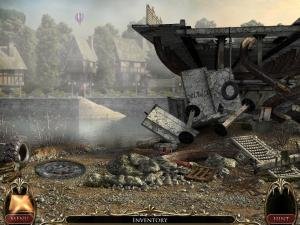 As it turns out, the story loosely relates to the legend of the “Great Serpent”, whose head appears periodically to hiss at your efforts while its tail can frequently be seen slithering around a corner just as you arrive in new areas. Really it’s the not-so-great Sheriff you need to worry about, however. He’s imposed a curfew on this secluded section of town, terrorizing the few remaining residents apart from one little girl who seems to be the only other one (besides yourself) to disobey his orders. When he inevitably catches you continuing to roam the city, he’ll lock you up in jail and cellars to teach you a lesson you naturally never learn. To progress through the game, you need to help each person with some unfinished business, whether reuniting estranged families, cracking money-filled safes, or finding missing items. As you do so, you’ll earn special talismans that weaken the city’s barrier and cause visions that reveal hints as to your real condition. (And by “hints”, I mean blatantly giving it all away the first time you see one.)
As it turns out, the story loosely relates to the legend of the “Great Serpent”, whose head appears periodically to hiss at your efforts while its tail can frequently be seen slithering around a corner just as you arrive in new areas. Really it’s the not-so-great Sheriff you need to worry about, however. He’s imposed a curfew on this secluded section of town, terrorizing the few remaining residents apart from one little girl who seems to be the only other one (besides yourself) to disobey his orders. When he inevitably catches you continuing to roam the city, he’ll lock you up in jail and cellars to teach you a lesson you naturally never learn. To progress through the game, you need to help each person with some unfinished business, whether reuniting estranged families, cracking money-filled safes, or finding missing items. As you do so, you’ll earn special talismans that weaken the city’s barrier and cause visions that reveal hints as to your real condition. (And by “hints”, I mean blatantly giving it all away the first time you see one.)
There’s really no story here beyond that, though despite giving its only twist away early and obviously, it’s an interesting enough backdrop for a hidden object adventure. Unfortunately, the whole “hidden object” part isn’t much fun. There are plenty of standard hunts for random lists of non-interactive objects, and many of the scenes are shown fairly close up, which should have allowed for plenty of detail. Instead we’re given relatively sparse environments that are only difficult due the washed-out, muddy nature of the graphics. This applies to the whole game, which is a dreary, unattractive mix of greys and browns as you wander the cloud-covered town. The artistry is decent, showing a few compelling scenes of crumbling streets and collapsed bridges, but much of your time will be spent wandering entirely nondescript buildings like houses, offices, a garage, store, school, and a quick trip through the tunnels as you inadvertently break into jail. It’s all very drab and lifeless, as even the characters aren’t fully animated, instead moving through a sequence of staggered stills.
There are inventory puzzles to solve along the way, a few of which even involve item combination, though this feature is largely forgotten for most of the game. Item use is usually fairly obvious; item acquisition is less so. Whether you’re searching for fuses, gears, or windmill sails, often necessary items are doled out very randomly and sporadically. Sometimes you may even need to visit the same hidden object scene a second time just to pick up an object you weren’t given the first time. This makes progress feel far too arbitrary, as you’ll rarely know where to go to look for new objects, or even when they’ll become available. Objectives are nicely tracked in the journal, and the hint system is quite useful in sending you to the next relevant location without specifying why, but hints are no substitute for intuitive gameplay.
Logic puzzles are few and far between, which is probably good as they aren’t particularly enjoyable and rarely pose much challenge. A card-based memory game provides a nice twist on the standard Concentration formula, but that’s about the only originality shown among the lot of stacking, slider, and simple weight and math puzzles here. Several code locks require clues found elsewhere, and a doll-sorting riddle at least feels a little different, but not even these will slow you down for long. This certainly helps explain why you’ll reach the end after only two and a half hours, though at least the story resolves itself satisfactorily to reward your meagre efforts.
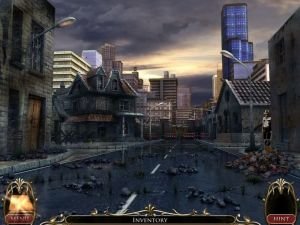 The Collector’s Edition bonus chapter tacks another three-quarters of an hour onto that, flashing back to the story of the frightened little girl running loose. Her story is actually one of the game’s few bright spots, though not nearly enough is done with it in the main adventure. Disappointingly, the bonus chapter doesn’t really do much more. You already know the reason for her entrapment in the city, so the impact is gone apart from one brief instance where she hears her mother’s echoed voice (oddly, the only voice acting anywhere in the game) calling her through a radio. Otherwise, the game plays exactly the same, only this time in subterranean caves as you discover the tenuous connection between the Sheriff and the Great Serpent. With only two puzzles (one a bog-standard slider) and a slew of repeating item hunts, there’s nothing here that can’t be easily skipped if you’d rather opt for the standard version.
The Collector’s Edition bonus chapter tacks another three-quarters of an hour onto that, flashing back to the story of the frightened little girl running loose. Her story is actually one of the game’s few bright spots, though not nearly enough is done with it in the main adventure. Disappointingly, the bonus chapter doesn’t really do much more. You already know the reason for her entrapment in the city, so the impact is gone apart from one brief instance where she hears her mother’s echoed voice (oddly, the only voice acting anywhere in the game) calling her through a radio. Otherwise, the game plays exactly the same, only this time in subterranean caves as you discover the tenuous connection between the Sheriff and the Great Serpent. With only two puzzles (one a bog-standard slider) and a slew of repeating item hunts, there’s nothing here that can’t be easily skipped if you’d rather opt for the standard version.
The real question is whether it’s worth even bothering with that. Resurrection, New Mexico is one of the lesser casual games released as a CE, as its story isn’t particularly creepy and the gameplay is entirely uninspired. If you just can’t get enough of haunted town tales, you may want to give it a try; just don’t get your hopes up for anything special, because there’s nothing here that will raise them.
Love Story: The Beach Cottage
by Jack Allin
Media Art was busy this month. Love Story: The Beach Cottage will certainly tug at your heartstrings, though not always for the right reasons. You’ll be truly touched by a charming tale of childhood sweethearts torn apart by tragedy, feel mildly entertained by a nice mix of lite adventuring and hidden object hunts yet slightly annoyed at the ease and randomness of the gameplay, and then feel jilted when the whole affair wraps up in less than two measly hours, at least on the easier of two difficulty settings (and not much more on the harder one). In gaming terms, I’m not even sure that qualifies as a one-night stand.
 Featuring an entirely new protagonist than the first Love Story, Sandra Walsh is dealing with the death of her father, whose final wish in a posthumous letter is for her to revisit the old family beach house in North Carolina. The once-idyllic summer home has been the source of a painful memory she’d really rather forget for over 40 years, but “Sandie” relents and agrees to face the cottage one last time. Upon her arrival, she finds that a storm has severely damaged the property, so she’ll not only have to deal with a broken heart while she’s there, but plenty of broken equipment as well.
Featuring an entirely new protagonist than the first Love Story, Sandra Walsh is dealing with the death of her father, whose final wish in a posthumous letter is for her to revisit the old family beach house in North Carolina. The once-idyllic summer home has been the source of a painful memory she’d really rather forget for over 40 years, but “Sandie” relents and agrees to face the cottage one last time. Upon her arrival, she finds that a storm has severely damaged the property, so she’ll not only have to deal with a broken heart while she’s there, but plenty of broken equipment as well.
The game is split into two very distinct modes. In present day, Sandie must wander the house, the beach, the nearby docks and a lighthouse collecting inventory items to repair ladders, pumps, and telescopes. On the easy setting, any items needed to accomplish these tasks are stored in the inventory as silhouettes once the goal is triggered. That may sound like it reduces the challenge significantly, but I barely glanced at them. For one thing, the item uses are always straightforward: it isn’t brain surgery to figure out what a screwdriver, insulating tape, or axe is used for. But the “inventory” items also end up overwhelming the available slots anyway. Scrolling through as many as five items and ten silhouettes at a time is far more hassle than simply getting on with your adventure and finding what you need the old-fashioned way.
Along the way, Sandie must also save some stranded crabs, go fishing, and reminisce about treasure chests, messages in bottles, and a legendary “cave of love”. These recollections occur through playable flashbacks that consist largely of hidden object searches. These are varied, however, as along with straightforward item lists you’ll search for complete item sets and related pairs, sometimes with a great deal of interactivity to find them. The gameplay is less interesting in these sections, but here is where the important story gaps are filled in through cutscenes, gradually unveiling a sad tale of two childhood friends who were totally devoted to each other and destined for a life together, then separated by an accident that Sandie clearly feels intensely guilty about. It’s all presented through a series of voiceless stills, but their affection for each other shines through clearly, and you’ll soon understand – even share – Sandie’s wistfulness.
 There are puzzles to be solved in each era as well, including jigsaws, sliders, coloured wire connections and stacking tasks. Most are familiar types, but one symbol-swapping challenge is cleverly implemented with an additional weighting requirement so that papers don’t fly off in the breeze. I say “challenge”, though apart from one convoluted puzzle whose instructions are clear as mud, there’s little difficulty to be found here. Even the single balloon-popping minigame is a cinch, though just waiting around for the correct balloon colours is an exercise in frustration. The harder difficulty setting increases the puzzle challenge slightly, but not enough to make a serious difference. There’s a puzzle skip button, of course, though there’s no journal, map, or task list of any kind to aid you otherwise. The hint feature is fairly useful, however, offering you a text hint of where you should go next, leaving the actual what and why to you once you’re there.
There are puzzles to be solved in each era as well, including jigsaws, sliders, coloured wire connections and stacking tasks. Most are familiar types, but one symbol-swapping challenge is cleverly implemented with an additional weighting requirement so that papers don’t fly off in the breeze. I say “challenge”, though apart from one convoluted puzzle whose instructions are clear as mud, there’s little difficulty to be found here. Even the single balloon-popping minigame is a cinch, though just waiting around for the correct balloon colours is an exercise in frustration. The harder difficulty setting increases the puzzle challenge slightly, but not enough to make a serious difference. There’s a puzzle skip button, of course, though there’s no journal, map, or task list of any kind to aid you otherwise. The hint feature is fairly useful, however, offering you a text hint of where you should go next, leaving the actual what and why to you once you’re there.
Parting may be sweet sorrow, but you’ll have to confront that reality a lot sooner than you want. Before it’s done, the story takes a particularly sentimental detour that strains credibility and then ends rather suddenly after only two hours. It’s not like the developers sunk the budget into production values, as this is a pleasant looking game but far from dazzling. Showing the same scenes in different periods provides a nice variation but limits the actual number of locations overall. And while there are some suitable ambient sounds of crashing waves and seagulls, the gentle instrumentals that loop throughout are both sappy and repetitive. So ultimately what you’re (potentially) paying for is a couple hours of star-crossed lite adventuring romance. If you’re a sucker for such things, Love Story: The Beach Cottage does deliver a sweet tale, but don’t be surprised if its simple gameplay and short length are what leave you crying in the end.
The Dark Hills of Cherai: The Regal Scepter
by Jack Allin
Good things may come in threes, but sometimes three’s a crowd. A little of both is true in ChaYoWo Games’ The Dark Hills of Cherai: The Regal Scepter, a hidden object adventure with three playable characters. On the one hand, having a trio of protagonists work cooperatively by sharing items between them adds an intriguing new dynamic to the standard casual formula. On the other hand, given the game’s utterly random design structure, the end result is an experience that’s triple the usual amount of confusion and hassle. There’s still plenty of solid puzzle-solving and item scavenging to be done, but more than a few frustrations are shared along the way.
 This sequel is similar to its predecessor, though presenting more of a sprawling, open-ended adventure. The teenaged Tara and her younger siblings Maya and Rahul all return, this time sent off on a new adventure by the ghostly King of Cherai to reclaim a legendary scepter before an evil magician finds it first. To do so, they’ll need to split up in search of twelve amulets that unlock the chamber it’s hidden in, and twelve gems to power the scepter itself. You’ll also collect a host of other objects as you go, from puppets to ritual dust to coloured urns and numerous keys, along with many, many inventory items – even an ox!
This sequel is similar to its predecessor, though presenting more of a sprawling, open-ended adventure. The teenaged Tara and her younger siblings Maya and Rahul all return, this time sent off on a new adventure by the ghostly King of Cherai to reclaim a legendary scepter before an evil magician finds it first. To do so, they’ll need to split up in search of twelve amulets that unlock the chamber it’s hidden in, and twelve gems to power the scepter itself. You’ll also collect a host of other objects as you go, from puppets to ritual dust to coloured urns and numerous keys, along with many, many inventory items – even an ox!
The trick here is that the items must be shared among the three in order to proceed. A tool Maya finds may be needed by Rahul, who himself has objects that Tara requires. Once each has unlocked a special temple, inventory can easily be transferred between them. Easily… but tediously. The game’s central gimmick feels like an inspired addition the first few times you swap objects, and a tiresome nuisance after that. Each child’s journey spans numerous screens and multiple objectives, and it’s incredibly easy to lose track of who needs what item where, even if the actual solution is ultimately obvious. Not only are you virtually guaranteed that every item you find will be needed by one of the others, it may not be until much later – or conversely, discovered much later than the objective, giving you lots of time to forget all about it. Countless times I blindly gave something to one child, only to discover that wasn’t the one who needed it.
Fortunately, the game bends over backwards to be user-friendly in all other ways to compensate. Switching between protagonists is just a button click away, as is an instant return to the inventory temple. A quick travel map is available for each character, showing all cleared, pending, or unexplored areas, even highlighting active hidden object screens (which is useful given their arbitrary activations). The hint system has multiple options. The King of Cherai offers tips on advisable item swaps, while a recharging peacock (which feature prominently in this game) highlights any relevant hotpots onscreen or advises you to look somewhere else. You can also drag inventory items onto it for a small pictorial clue on its use (including scenes you may not have opened yet). All that sounds great, and it is, but doesn’t such a substantial hint system suggest that the design itself is unintuitive? In this case, that’s precisely what it means, so expect to use some hint or another far more often than you’d like, unless you’re prepared to spend plenty of time scanning maps or swapping items one at a time. Me, I’d rather be out adventuring and feeling like I’m solving things myself.
There’s still plenty to solve in the form of standalone puzzles, which run the gamut from sliders to mazes to rotating twiddleware to matching themed tiles. Some are as easy as identifying patterns or pairs purely through trial and error, while some can be far more challenging, like lighting, shifting, and extinguishing torches in a very specific way, or eliminating all items from a rotating circle. An overlapping strand puzzle and shuffling 3D blocks into place on a grid are shamelessly repeated three times in a row (seriously, developers, stop doing that – it’s obnoxious), but you can skip any that give you too much trouble. You’ll also scour numerous hidden object screens. These consist of straightforward lists of items that are fairly easy to locate, particularly when revisiting the same one a second time. The only difference from most games is that many hunts result in multiple items to take away for further use. (More stuff to share!)
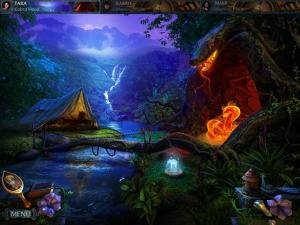 The upside to the sprawling nature of your journey is that there are many scenic locations to explore. You’ll visit various courtyards, a fortress tower, a sacred pool, a palatial hall, and even scour a shipwreck underwater. The graphics are nicely drawn, though as the entire game takes place in one night, the backgrounds rely heavily on cool blue hues. There aren’t too many animations, but you’ll discover a few nice touches like an elephant flapping its ears, while occasionally an evil creature like a flaming cobra or malevolent female Yakshi will appear to hinder your progress. Most of the cutscenes are voiced quite well, though there is little trace of East Indian accent, where the game is presumably set. The same applies to the music, which provides a moody ambience but feels culturally ambiguous apart from a few melodic chants.
The upside to the sprawling nature of your journey is that there are many scenic locations to explore. You’ll visit various courtyards, a fortress tower, a sacred pool, a palatial hall, and even scour a shipwreck underwater. The graphics are nicely drawn, though as the entire game takes place in one night, the backgrounds rely heavily on cool blue hues. There aren’t too many animations, but you’ll discover a few nice touches like an elephant flapping its ears, while occasionally an evil creature like a flaming cobra or malevolent female Yakshi will appear to hinder your progress. Most of the cutscenes are voiced quite well, though there is little trace of East Indian accent, where the game is presumably set. The same applies to the music, which provides a moody ambience but feels culturally ambiguous apart from a few melodic chants.
Eventually you’ll come face to face with the wicked Vishwarood himself, but the final confrontation feels a bit anti-climactic despite the implied drama that openly suggests we’ve not seen the last of him. I’d certainly accept another adventure for Tara, Maya, and Rahul, but here’s hoping the developers properly embrace the nature of cooperative gameplay next time instead of simply scattering items and goals helter-skelter across three paths instead of one. As it is, The Dark Hills of Cherai: The Regal Scepter succeeds in providing a welcome twist on the usual hidden object formula over its three and a half hour duration, though even with all of its user-friendly features, its over-reliance on a single gimmick begins to feel like a royal pain.
Campfire Legends: The Last Act
by Jack Allin
Gather round the fire everyone, and I’ll tell you a horrifying tale. Imagine, if you dare, that you’re playing a lite adventure from Absolutist set in an eerie mansion at night. Now picture having to find a slew of itty bitty items, whether batteries, keys, fuses, or clock hands in order to proceed. Oh no! The light goes out! Now you have only a faint, flickering flashlight to guide you… and then that dies! But prying loose boards off the window shines just enough midnight glow to let you move on. At least that should make it easier to spot fireflies that serve as the hint system – except these don’t glow! No, they’re just more tiny, dark images against a pale, eye-straining background. They’d actually be harder to find than the objects you need, except that so many items are not only small but obscured to the point where only a tiny portion is visible. Scared yet? Welcome to Campfire Legends: The Final Act.
 Oh sure, there’s a real horror story involved here as well, but if not for the fact that this is (presumably) the finale of a series that offered so much promise in The Hookman and The Babysitter, I wouldn’t have even bothered covering this game, because the real terror comes from its shocking lack of user-friendliness and fun. The premise begins with two girls driving to a secret rendezvous with their campfire friends in the woods when a zombie-looking creature appears in front of them, causing them to crash. When Reggie comes to, Ashley is nowhere to be found, but the only place she can be is in the creepy mansion nearby, which just so happens to be the same house where Reggie’s sister Lisa was previously killed. You’ll soon meet up with Ashley once again, but the two of you aren’t alone, and only by discovering hidden diary pages and recordings from Lisa can you piece together the terrible secrets of this decrepit manor and the “monster” of Stillwater Sanitorium.
Oh sure, there’s a real horror story involved here as well, but if not for the fact that this is (presumably) the finale of a series that offered so much promise in The Hookman and The Babysitter, I wouldn’t have even bothered covering this game, because the real terror comes from its shocking lack of user-friendliness and fun. The premise begins with two girls driving to a secret rendezvous with their campfire friends in the woods when a zombie-looking creature appears in front of them, causing them to crash. When Reggie comes to, Ashley is nowhere to be found, but the only place she can be is in the creepy mansion nearby, which just so happens to be the same house where Reggie’s sister Lisa was previously killed. You’ll soon meet up with Ashley once again, but the two of you aren’t alone, and only by discovering hidden diary pages and recordings from Lisa can you piece together the terrible secrets of this decrepit manor and the “monster” of Stillwater Sanitorium.
The basic gameplay hasn’t changed much from the first two titles, as you’ll still spend much of your time hunting down items needed to proceed. There are no traditional hidden object hunts, as everything you collect is theoretically necessary and stored in inventory for later use, though to compensate you frequently need to find multiples of the same item. Whereas most people only blow one fuse at a time, this place needs many, and the lone car key you need could be one of several scattered around. Once a new objective is triggered, any items required to fulfill it (or at least, the first known stage) are shown in a bar at the bottom of the screen. If finding those sounds easy, think again, because the developers have thrown just about every stumbling block imaginable in your way. The real items look nothing like the images displayed, and they’re often so tiny and concealed that you can look right at them in their darkened environments and not still recognize them. That may drive you to the hint button, but if you want more than the single absurdly slow-recharging hint available, you’ll need to collect sporadically respawning bugs that are equally difficult to spot. If you want a scavenging challenge, you’ll certainly find that here; if you want to enjoy yourself, you’ll find that a challenge too.
When you do scrape up the necessary objects, they’re stored in a sidebar inventory where some can be combined in a close-up assembly screen. That’s a good thing, but constructing a broken cell phone is so unintuitive that it quickly soured me on the feature. Other puzzles are encountered as well, including standalone familiar types like sliders and gears, while a couple are more creative, like a colour-based domino challenge and a paper-folding exercise. Puzzles can be skipped, but I wasn’t inclined to use the option while I played, though because my experience of The Final Act was limited to the demo I can’t speak to the difficulty level throughout the rest of the game.
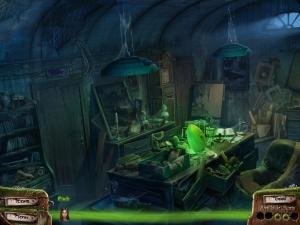 While so many elements feel like a step back for the series, at least the production values continue to be solid. The characters are fully voiced throughout an abundance of cinematics (many of which involve Reggie looking scared of some new shadow or unseen sound in the early going), and the backgrounds are nicely hand-drawn in a realistic fashion, though the shabby, darkened interiors I saw did little to show them off. Music plays periodically to set the haunting mood, which managed to be reasonably tense while I played, though that may have had more to do with the clock ticking down on my demo while I frantically squinted for yet another item.
While so many elements feel like a step back for the series, at least the production values continue to be solid. The characters are fully voiced throughout an abundance of cinematics (many of which involve Reggie looking scared of some new shadow or unseen sound in the early going), and the backgrounds are nicely hand-drawn in a realistic fashion, though the shabby, darkened interiors I saw did little to show them off. Music plays periodically to set the haunting mood, which managed to be reasonably tense while I played, though that may have had more to do with the clock ticking down on my demo while I frantically squinted for yet another item.
If this is indeed the final act of the Campfire Legends, it certainly isn’t going out in a blaze of glory. Perhaps the rest of the game improves dramatically, but while I’m willing to believe that the slow-smoldering start may grow into a deeper, richer horror tale with genuine chills, I’m far less inclined to accept that the punishing gameplay ever makes it worth the effort. If you’re new the series, you should steer well clear of this stifling, not-very-casual experience. If you’ve played the first two games, I probably can’t scare you away from seeing the trilogy through to the end, but prepare for disappointment as the series’ early potential disappears in a puff of smoke.
Note: Adventure Gamers is a Big Fish Games affiliate.






